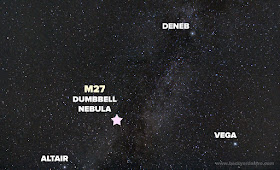The Dumbbell Nebula is well photographed by professional and amateur night sky photographers alike. It was one of the first deep-sky objects I imaged way back in 2011. A member of the astronomy forum I was a part of suggested that I give it a try, as it is a very gratifying object to image due to it's brightness. Sure enough, there it was! Even a 30 second exposure was enough to make this interesting planetary nebula "pop" on my display screen. I have re-imaged this object several times since that first night, and realized that it takes hours of exposures to increase the detail in this nebula. My 4 hour exposure looked disappointingly similar to my 1 hour shot! This photo is an oldy, and I can't wait to image it again this fall once I get my 8" Orion Astrograph back up and running. I should also note that this was taken back when I was using my beloved Celestron CG-5 mount.
Now that my Canon Xsi is modified to increase the sensitivity to the colour red and the H-alpha wavelength, I can pick up much more detail around the edges of M27. The increased focal length of my larger scope (800mm) is also better suited for this rather small target.
PHOTO DETAILS
M27 - The Dumbbell Nebula
Imaged Saturday, July 28th, 2012
Imaged Saturday, July 28th, 2012
Telescope: Explore Scientific ED80 with WO Flat III 0.8x FR/FF
Mount: Celestron ASCG-5
Guiding: Meade DSI Pro II and PHD Guiding
Guide Scope: Orion Mini 50mm
Camera: Canon EOS 450D (Stock)
ISO: 1600
Total Exposure: 3 Hours, 30 Minutes (60 x 210 seconds)
Processing Software: Deep Sky Stacker, Photoshop CC
Support Files: 15 dark frames
Mount: Celestron ASCG-5
Guiding: Meade DSI Pro II and PHD Guiding
Guide Scope: Orion Mini 50mm
Camera: Canon EOS 450D (Stock)
ISO: 1600
Total Exposure: 3 Hours, 30 Minutes (60 x 210 seconds)
Processing Software: Deep Sky Stacker, Photoshop CC
Support Files: 15 dark frames
The Dumbbell Nebula was the first planetary nebula to be discovered by Charles Messier in 1764. Not surprising, as this object has a visual magnitude of 7.5! (Thanks Wikipedia!) It is easily visible in binoculars and small telescopes if you know where to look. It is located in the constellation Vulpecula, at a distance of about 1,360 light years. The human eye will only perceive this nebula as a white, two-lobed structure.
 |
| Location of Dumbbell Nebula - Source Wikipedia |
Location of the Dumbbell Nebula
To find it begin at Altair and navigate back towards Deneb in Cygnus, right through the summer triangle. About one quarter of the way back to Deneb, you will find a bright orange star (Y Sagittae). Continue to connect the line between Altair and Y Sagittae by another 2°, and you should come to a barely visible naked-eye star, 14 Vulpeculae. Messier 27 is right next to this star and will look a cloud-like object through your telescope or binoculars. Below you will find a handy star-chart I made using one of my wide field photos of the night sky from my backyard.
Star-Chart
Did you notice the www.astrobackyard.com watermark? That's right, I am transitioning into a brand new website with advanced features and one that is much more professional and user-friendly. I am very excited about this move and have been waiting for this moment for a very long time! Thank you to all of the regular visitors of this blog and your continued support!



No comments:
Post a Comment